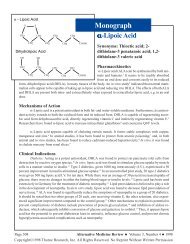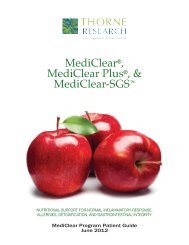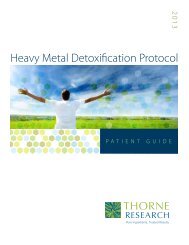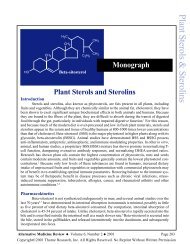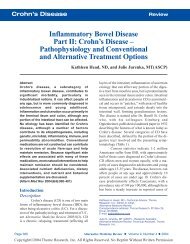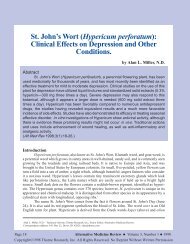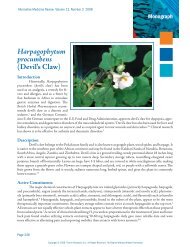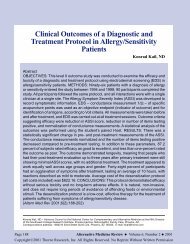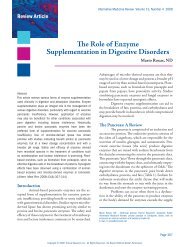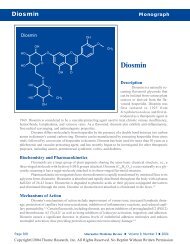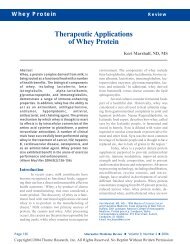Panax Ginseng - Thorne Research
Panax Ginseng - Thorne Research
Panax Ginseng - Thorne Research
You also want an ePaper? Increase the reach of your titles
YUMPU automatically turns print PDFs into web optimized ePapers that Google loves.
Review<strong>Panax</strong> ginseng and Cancerabuse syndrome” has also been reported withdoses up to 15 g/day, averaging 3 g/day, with concomitantuse of caffeinated beverages. Symptomswere characterized by hypertension coupled withnervousness, sleeplessness, skin eruptions, andmorning diarrhea in 14 patients. The syndromewas reported to reappear throughout the first yearof the trial, but was found to be rare at 18 and 24months. 105<strong>Ginseng</strong> standardized to four-percentginsenosides has been found to increase the lumenalclearance of albendazole sulfoxide, anantihelminthic drug, speaking to both the need forconcern with lowering serum levels of the benzimidazole-containingdrugs and the possible adjunctivedelivery of therapeutic agents to disturbancesof the bowel. 106Studies with P. ginseng are often of shortduration and the majority of trials include a relativelysmall number of patients, thus reducingpotential reports of rare and delayed adverseevents. Conversely, three case control studies inKorea with more than 10,000 patients providedno information regarding adverse effects. 107-109Reports of toxicity are rare in Germany and otherEuropean countries in which ginseng is medicallyprescribed. Indeed, both the World Health Organizationand the Commission E conclude that, inrecommended doses (1-2 g of the crude drug or200-600 mg of standardized extracts – calculatedto 4-7 percent ginsenosides), there are no knownside effects of P. ginseng. 13ConclusionCancer is both a systemic concern and aspecific disease. The goal of cancerchemoprevention is to inhibit the induction andsuppress the progression of preneoplastic lesionsto invasive cancer. P. ginseng’s protective effectsfrom toxic insult are well documented and speakwell to prophylactic use, especially in patients athigh risk for liver cancer. The ability to decreaseinflammation and increase antioxidant activitysustains ginseng’s role as an antitumor agent.Induction of apoptosis is an area where the geneticmechanisms of ginseng are becoming bestunderstood. Unfortunately, the inhibition ofproliferation has had limited success, with futuretherapeutics on the horizon via neurotransmittermodulation. Therefore, given the short interval ofinitiation and progression (which are generallyconsidered irreversible), the promotion phase mayprovide the best target for cancer prevention.Much anecdotal evidence is claimed, butthere is no conclusive proof P. ginseng cures anytype of cancer. Nonetheless, evidence points toginseng’s ability to limit and slow growth as wellas to enhance the ability of the immune systemand tumor cells to overcome chemotolerance andincite apoptosis. The ability of P. ginseng to increasethe effectiveness of other chemotherapeuticagents, to act synergistically, and to help lowerdoses and therefore adverse side effects, is increasinglydocumented. <strong>Ginseng</strong> and its constituentsexhibit key properties that allow precancerouscells to be limited to the promotion phase or to bedestroyed altogether.Despite the lack of Western-style scientificexperimentation, the use of P. ginseng forcancer is well accepted in China. This herbal therapeuticagent has only gained scientific attentionin the West since 1972 when U.S. President Nixonvisited China and successfully opened relations.Nonetheless as P. ginseng experimentation continues,its recognized potential in cancer therapeuticscontinues to grow.References1. Blumenthal M. Herb sales down 15 percent inmainstream market. Herbalgram 2001;51:69.2. Tachikawa E, Kudo K, Hasegawa H, et al. Invitro inhibition of adrenal catecholaminesecretion by steroidal metabolites of ginsengsaponins. Biochem Pharmacol 2003;66:2213-2221.3. Lee Y, Jin Y, Lim W, et al. A ginsenoside-Rh1,a component of ginseng saponin, activatesestrogen receptor in human breast carcinomaMCF-7 cells. J Steroid Biochem Mol Biol2003;84:463-468.4. Shibata S. Chemistry and cancer preventingactivities of ginseng saponins and some relatedtriterpenoid compounds. J Korean Med Sci2001;16:S28-S37.Alternative Medicine Review ◆ Volume 9, Number 3 ◆ 2004 Page 269Copyright©2004 <strong>Thorne</strong> <strong>Research</strong>, Inc. All Rights Reserved. No Reprint Without Written Permission



